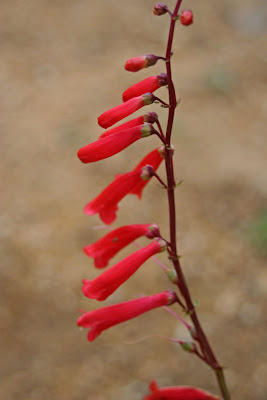4/11/10
It was cool and overcast that afternoon, perfect weather to release the ladies, and so I did. And, as always, they went right to work on the offending faction. I've been using ladybugs every spring for the past several years as a biological control and they've always, without fail, kept the aphid population in check.
Speaking of bio controls, I've got to give a plug here to Rosie's blog over at Leaves 'n Bloom, because she has a great post called "Biodiversity and Lacewings in the Garden" http://leavesnbloom.blogspot.com/ . It's really fun and informative, and takes on the clever guise of an ad campaign for a new Five Star luxe "Lacewing Hotel." You go, girl!
The California natives are continuing to bloom in the garden, and I snapped these shots before the wind really kicked up in the afternoon. We did get over an inch of rain from last night's rainstorm, which will undoubtedly help to prolong our wildflower season.
4/11/10 Blue Flax (Linum lewisii). Native to dry slopes and ridges throughout California. I've seen these in the Eastern Sierras (Virginia Lakes in the Toiyabe National Forest) and in Modoc County (County Rd. 73 to Big Sage Reservoir in the Devil's Garden Natural Area). In full bloom, they are a real sight to behold with their multitude of sky-blue flowers along wispy, arching wands. Available from Las Pilitas Nursery and Annie's Annuals.
4/11/10 Prickly Phlox (Leptodactylon californicum).
4/11/10 'San Gabriel' Fremontia.
4/11/10 Ruby Chalice Clarkia (Clarkia rubicunda blasdalei).
4/11/10 'Shamini' Clarkia (Clarkia rubicunda).
4/11/10 'Blue Springs' Foothill Penstemon (Penstemon heterophyllus).
4/11/10 'Margarita BOP' Penstemon (P. heterophyllus x P. laetus). An indispensable selection from Las Pilitas Nursery.
4/11/10 Eaton's Penstemon (Penstemon eatonii). The vibrant scarlet flowers of this drought tolerant penstemon bloom on spikes up to 3 feet in height. Native to the foothills and mid-elevations of the San Bernardino and desert mountains.

4/11/10 Desert Four O'Clock (Mirabilis bigelovii). Native to the E. Colorado & Mojave deserts. This plant is about 2 years old and, surprisingly, thriving in my "wanna be" desert garden. From an 8" tall sproutling in a 1-gallon container, it's now grown to about 2' x 4'.
4/11/10 Salvia "Celestial Blue" (Las Pilitas Sage). According to Las Pilitas Nursery, "a hybrid between Salvia clevelandii x S. pachyphylla, or a 3 way hybrid with 'Pozo Blue.'" Either way, a stunning blue-flowered sage.
Fivespot (Nemophila maculata). Native annual, endemic to California.
4/11/10 Sticky Cinquefoil (Potentilla glandulosa). Common in many habitats throughout the California Floristic Province. I've seen them streamside in montane areas (San Jacintos, Cuyamacas, Eastern Sierras) and under the shade of oaks on the Santa Rosa Plateau.
4/11/10 Goldfields (Lasthenia californica).
'Shasta Sulphur' Buckwheat (Eriogonum umbellatum).
And last but not least are the scarlet-bloomed monkey flowers that are native to our site. You can also see a gazillion of these blooming right now off Clinton Keith Road just past the Bear Creek Fire Station as you drive up to the Plateau.
4/11/10 Bush Monkeyflower (Diplacus aurantiacus)




















Thanks for the link Arleen to my lacewing hotel. I'm just back from holidays so trying to catch up on my favourite blogs. I've never seen ladybugs sold in tubs like that before. They are just fantastic to have around the garden as they and especially their larvae eat so many of those little sap sucking beasties.
ReplyDeleteI don't recognise the names of your natives but I can see some similarities between them and their "f1 hybrids" so to speak that we grow as plants in the garden especially in the Clarkia.
Welcome back, Rosie - hope you had a nice holidays! The "predators in a tub" as I call them are usually available in the spring in some of our specialty nurseries. I've only bought ladybugs, but mantids and lacewings are also available on occasion. Such a great alternative to spraying.
ReplyDeleteThe blue flax is the only familiar mediterranean plant to me amongst these Californians. Our species is different, but the drift of blue effect will be the same. One of my volunteers has come up pink. Do you get unexpected colours too?
ReplyDeleteElephant's Eye, I've only seen blue in the blue flax, but you never know - I've seen unusual color forms in some of our other wildflowers.
ReplyDelete